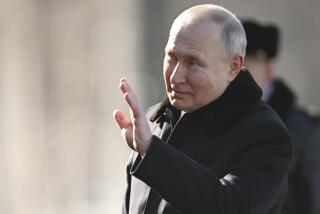‘Star Wars’ Sticking Point Delays U.S.-Soviet Summit
- Share via
MOSCOW — Mikhail S. Gorbachev could not get the United States to limit “Star Wars” development and refused Friday to set a date for a summit with President Reagan to sign a ban on medium-range nuclear missiles.
Secretary of State George P. Shultz delivered the news after two days of talks with the Soviet leader and other top Soviet officials, then left for Brussels to brief the NATO allies.
Shultz and Eduard A. Shevardnadze, the Soviet foreign minister, said the superpowers were close but could not quite agree on final details of a treaty to scrap the medium- and short-range missiles.
“We have made progress through some of the stickiest issues,” Shultz told a news conference. ‘We are, I think both sides agree, virtually there.”
He said the superpowers still are hung up on verification procedures, but differences over the U.S. program to develop the “Star Wars” space-based missile defense shield was the chief obstacle.
“Gorbachev is apparently not yet satisfied, partly in the area of space defense,” Shultz said.
The issue also has come up in talks on reducing strategic, or long-range, nuclear forces. Gorbachev agreed in February to separate those talks from negotiations on intermediate weapons.
Shevardnadze said agreement on intermediate-range weapons was “beyond doubt” and that a draft treaty could be prepared in two or three weeks.
He said Gorbachev proposed a moratorium beginning Nov. 1 on production, testing and deployment of the medium- and shorter-range weapons that would be scrapped under such an agreement.
Gorbachev also made “very important new proposals” to Shultz on setting levels for different types of strategic arms, he said.
Each superpower would be limited to 3,000 to 3,300 warheads for ballistic missiles, 1,800 to 2,000 for submarine-launched weapons and 800 to 900 for cruise missiles carried on strategic bombers, Shevardnadze told reporters.
“These data are very close to positions that have been repeatedly expressed by representatives of the U.S. Adminstration,” he said.
Radar Installations
The foreign minister said Gorbachev told Shultz the Soviet Union was ready to suspend construction of a radar installation in Krasnoyarsk for 12 months, and he hoped that the United States would freeze work on a similar unit in Scotland. Each country has accused the other of violating existing arms treaties by building the radars.
Shultz and his 100-member entourage arrived in Moscow hopeful that they could set a date for the third summit between Reagan and Gorbachev.
But he said Gorbachev would not feel “comfortable” in coming to the United States unless Reagan changes his position on the Strategic Defense Initiative.
“The President feels very strongly we must do everything we can to defend ourselves” against the threat of ballistic missile attack, Shultz said.
“The general secretary is not prepared to set a date” for a summit but still “holds open the possibility of coming to Washington this year,” he said.
Hopes for Summit
He made the announcement after a 4 1/2-hour meeting with Gorbachev and separate talks with Shevardnadze. Both sides had hoped that the talks would lead to a treaty the superpower leaders could sign during a U.S. summit.
Shultz did not identify Gorbachev’s specific demands on the Strategic Defense Initiative, but he said they appeared to reflect a change in position. Shultz said Gorbachev would outline his views in a letter he expects to send Reagan soon.
As Shultz left Moscow to confer with Western European foreign ministers in Brussels, Shevardnadze said “all the main issues connected with the elimination of medium- and shorter-range missiles have been resolved in principle,” the official Soviet news agency Tass reported.
The treaty, on which Shultz and Shevardnadze announced an agreement in principle after meeting in Washington last month, would eliminate all superpower missiles with ranges between 315 and 3,125 miles. Most of those missiles are deployed in Europe.
A senior U.S. official said that Gorbachev sought to “crack” the “Star Wars” program and had badly misread Reagan’s dedication to it.
Had Appeared Willing
The official, speaking on condition of anonymity, said that until Shultz came to Moscow, the Soviets appeared willing to hold a Washington summit to sign the intermediate-range missile treaty while continuing to work on strategic weapons and space defense issues.
In Washington, White House spokesman Marlin Fitzwater said: “The issue seems to be whether or not Gorbachev wants to come to the United States for a summit.
“He has raised the SDI roadblock. Certainly he knows that the President is not going to make SDI a bargaining chip.”
It was the second time that Soviet insistence on limiting Star Wars blocked agreement on other arms control issues.
At Reykjavik, Iceland, a year ago, Reagan and Gorbachev came close to agreement not only on intermediate-range missiles but on a 50% reduction in strategic forces and eventual elimination of their nuclear arsenals.
That meeting fell apart when the leaders failed to resolve their impasse over space-based defenses. The two first met in Geneva in 1985.
More to Read
Sign up for Essential California
The most important California stories and recommendations in your inbox every morning.
You may occasionally receive promotional content from the Los Angeles Times.









